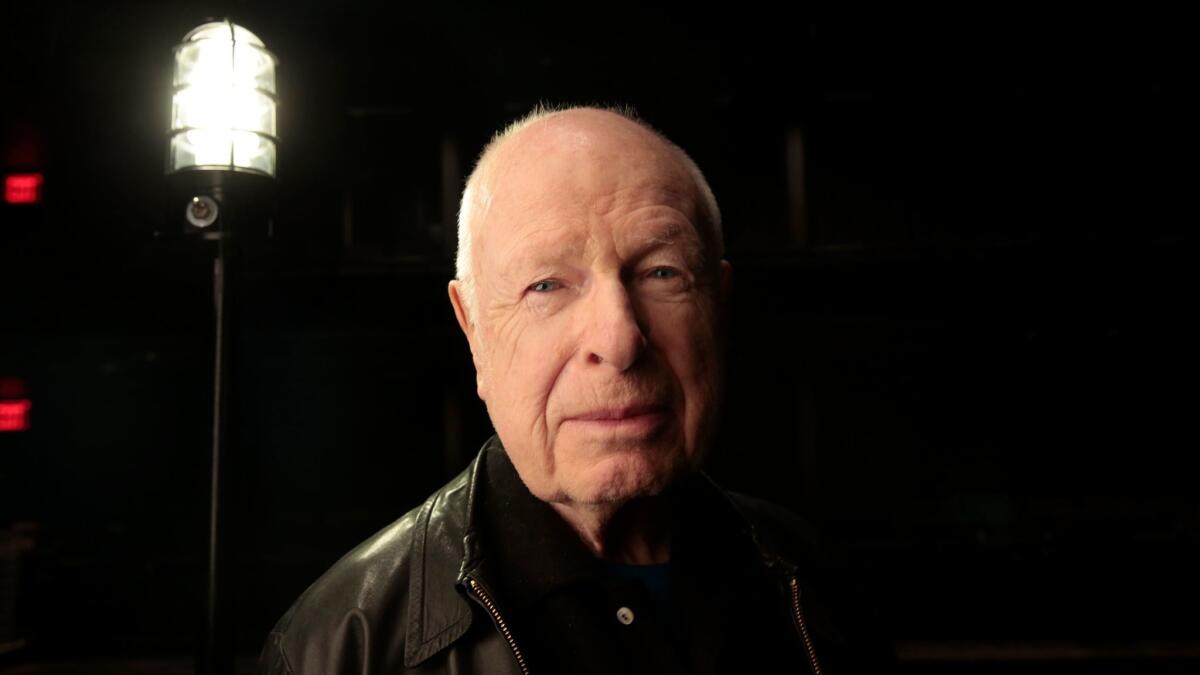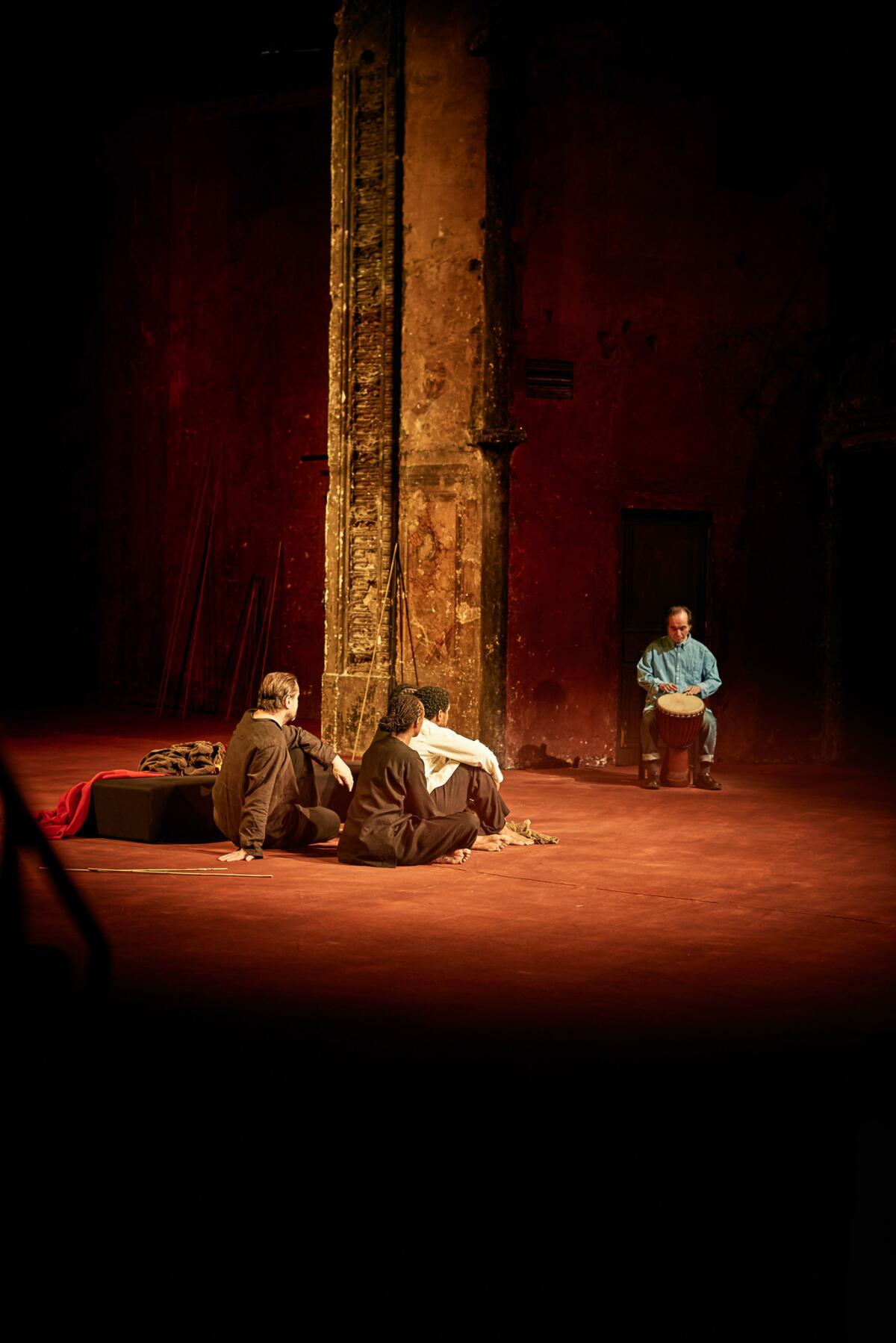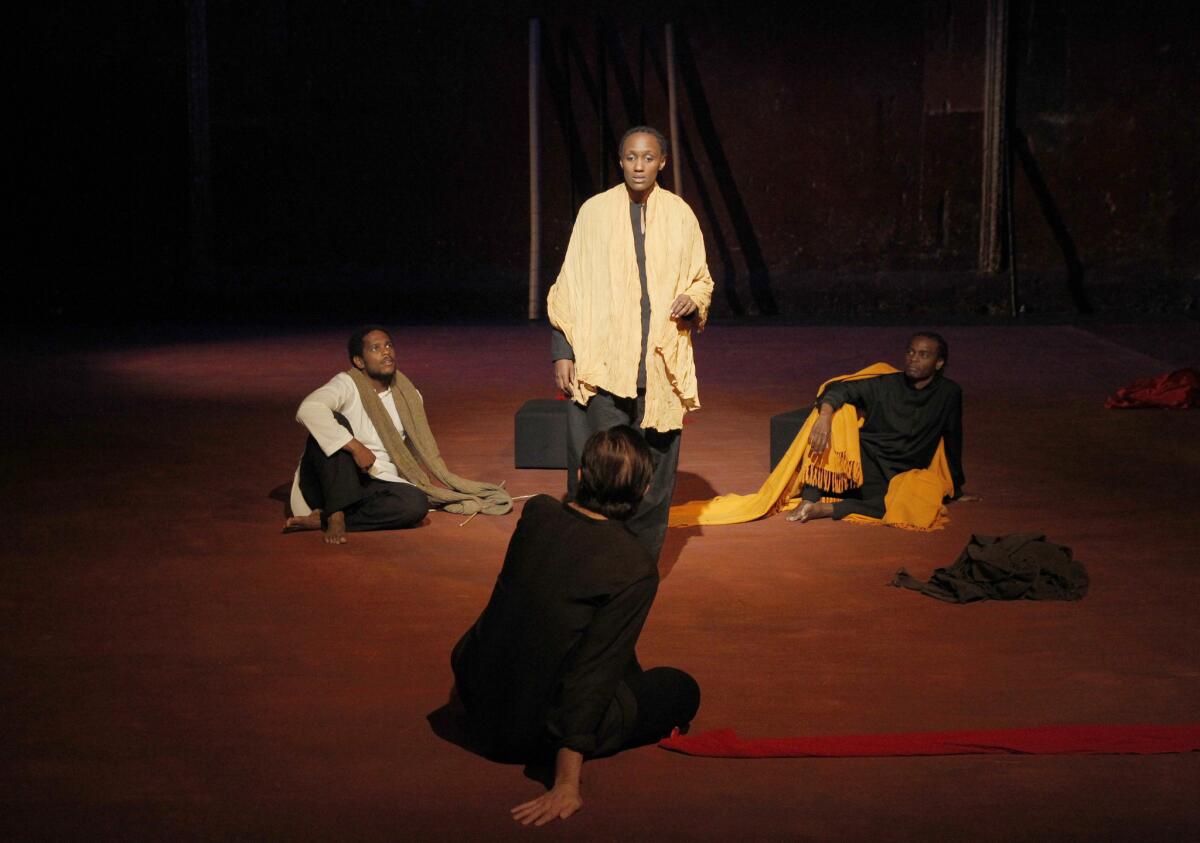Portrait of the artist as an ageless man: At 92, Peter Brook treads a different path through ‘The Mahabharata’

- Share via
Director Peter Brook, still at it at 92, has lived through nearly a century of theater history. You’d never know it, though, by the way he moves through the world, traveling as light as possible so that he can continue to probe secret depths.
The “immediate” theater, the category Brook came up with in his indispensable book “The Empty Space” to oppose the “deadly” theater of moribund tradition, remains his ultimate goal. Sitting in the Sky Lobby bar of American Conservatory Theater’s historic Geary, where his latest production, “Battlefield,” is playing before heading to the Wallis Annenberg Center for the Performing Arts in Beverly Hills on Wednesday, he continues to exist in the pulse and flow of the shared moment — his life force apparently generated by the same human circuitry that supplies the current to his productions.
Wrapped in a scarf that seemed to be protecting him from the indoor elements, Brook spoke softly in rich, cultivated tones that reflected both his Oxford education and his global citizenship as an artistic explorer. His precise yet pliant conversation complemented the meditative vigor of his directorial aesthetic.
“What is the meaning of a theater event?” he asked in the manner of a gentle Socrates. “The meaning of a theater event is that none of us could see something so clearly as with the new energy that is brought with the meeting of a theme, actors living it and an audience gradually entering it to live it with them. At that moment a certain light appears, revealing what we would never have thought of on our own.”
Brook’s answers are never declaimed as though they were conclusions. His wisdom has a provisional quality not unlike that found in the plays of his lifelong touchstone, Shakespeare. It’s remarkable in these careerist times to encounter an artist who has been so thoroughly transfigured by the art he has made that he seems untouched by the corrosive effects of the fame it has brought him.
The title of greatest living theater director, while debatable, isn’t empty flattery. Brook has led some of the finest English actors (Paul Scofield, Alec Guinness, Laurence Olivier, among them) to unforeseen heights. His productions of “Titus Andronicus,” “King Lear” and “A Midsummer Night’s Dream” revolutionized contemporary Shakespearean stagecraft. In “Marat/Sade,” Brook synthesized the revolutionary influences of Brecht and Artaud in a groundbreaking production that, like his sublimely craggy “Lear” with Scofield, has had a second life on film.
After Brook left Britain to escape what he called the artistic trap of “nationalism,” he established, in 1970, his International Centre for Theatre Research in Paris, beginning an illustrious second (or is it third?) act in intercultural performance. “The Mahabharata,” a nine-hour marathon bringing to life parts of the ancient Sanskrit epic, is considered by some to be his masterwork from this period.
In “Battlefield,” Brook revisits “The Mahabharata” (which premiered at the Avignon Festival in 1985) with two principals of the creative team: writer Jean-Claude Carrière and longtime collaborator Marie-Hélène Estienne. Crystallizing the radical simplicity of the director’s late style, this latest foray into one of the seminal works of Hindu culture is anything but an exercise in theatrical nostalgia.
Re-creation for Brook is an express route to deadly theater. “Battlefield,” just 70 minutes long, is a distillation of a few of the original production’s central contemplative concerns presented with a sparseness that can seem like the inverse of the lush visual poetry of “The Mahabharata,” which combined simplicity of materials with spectacularly inventive means.
In “Great Lengths: Seven Works of Marathon Theater,” theater scholar Jonathan Kalb recalls the theatrical profusion of “The Mahabharata,” the way Brook’s “continually surprising, multicultural trove of staging techniques was like a montage of attractions that whipsawed attention from sensation to sensation.” By contrast, “Battlefield,” which premiered in 2015 at Théâtre des Bouffes du Nord (long Brook’s Parisian home), has the calmness of a pond disturbed by a few carefully thrown stones.

Four actors from different parts of the world and a brilliant percussionist (Toshi Tsuchitori, who has created unique musical tapestries for Brook’s productions, including “The Mahabharata”) share the minimally adorned set. Spectacle is scrubbed away to an extent that makes even Brook’s stark staging of “The Suit” (presented at UCLA’s Freud Playhouse in 2014) seem showy. The unvarnished acting brings to the fore the human presence of an ensemble that reflects the director’s vision of “a storyteller with many heads.”
Questions of cultural appropriation dogged “The Mahabharata” when it was the talk of the avant-garde world in the late 1980s. Brook still isn’t having it: “Shakespeare is played in every part of the world. It comes from England, but the English have never said that it belongs to us exclusively. When I first encountered the poem, I saw that this was one of the masterpieces of humanity, but for complicated historical reasons it had hardly emerged from India. I felt, and this is a pure piece of romantic imagination, that we had been called to be the servants of the epic, which had woken up and said, ‘There are people all over the world who would really be touched by this. The time has come to be in touch with them.’ ”
Brook estimated that his production of “The Mahabharata” took more than 10 years to prepare and produce. “You can’t do that without the work entering into you,” he said. “Marie-Hélène and I had it potentially inside us until the moment came when we suddenly felt that there was something in it that was so close to our predicament today.”
Provoked by the brutal Syrian civil war and all the misery and destabilization it has engendered, “Battlefield” begins at the end of a cataclysmic battle. Yudhishthira, overcome by the magnitude of destruction after killing his old enemy, whom he learns was in fact his brother, mournfully declares, “The victory is a defeat.” He wants to retreat into the woods but is urged to live out his destiny and become a just king — a path that leads him to relentlessly question the nature of justice, human and divine, in the cycle of history.
Brook believes that for humanity today the wheel is approaching Kali Yuga, the dark and chaotic phase described in Sanskrit scriptures. “We are in the very last part of a sliding slope going downwards,” he said with philosophical neutrality.
“I think if we see this as part of the cyclic nature of history, if we see this in simple mathematical terms, then we see that we are wasting our best energy if we complain and think we can put the clock back,” he said. “Look at all this terrorism — a man who after he kills takes his own life in a way that tries to kill a few other people along the way. There is no sense. But if we can bring something that makes a small number of people feel more hopeful, we can make a modest difference.”
Brook doesn’t have much faith in politics. “No act of government can save the world,” he said. “Democracy has to go on and one has to have elections, but they encourage the simplistic lie that men who make the greatest promises will be able to implement them. It doesn’t happen. But there are ones who make great promises and manage to do a little better and there are those who make great promises and don’t make it a little better. So that’s where the battlefield is — in our hearts.”
Although Brook has the aura of a sage, he rejects the kind of theater in which artists condescend to their audience by assuming superior knowledge. Such “pretension” offends him. It’s the problem he has with Brecht, whose “tremendous scenic talent” has been eclipsed by his theoretical writings. As for the influence of Artaud, Brook classified him with the modernist English theater artist Edward Gordon Craig “as visionaries who gave their life to try to say what meaningful theater could be,” even if they weren’t able to achieve it themselves in performance.
These great theater minds have inspired Brook, but he keeps a practical distance from theory. Scofield, whom he called the greatest actor he has ever worked with, cautioned him about bringing into the rehearsal room intellectual concepts that shed no light on the characters or dramatic situation. Brook sees himself as a guide who, after careful study of the terrain, works intuitively in a process he proudly calls “trial and error.”
I can bring something as vividly as possible to the stage, but what you draw out of it is up to you.
— director Peter Brook

SIGN UP for the free Essential Arts & Culture newsletter »
Long at war against theatrical stereotypes, he reiterated his thinking that “when doing ‘King Lear’ one had to understand Goneril and Regan and not see them from the start in the old slinky tradition of the evil sisters of pantomime." When asked what Shakespeare productions other than his own stand out in his memory, he recalled “the remarkable ‘Othello’ done by the National Theatre a few years ago in which for the first time Iago was completely understandable.” (He was referring to Nicholas Hytner’s sensational 2013 London staging, with Rory Kinnear’s Iago spinning a cunning web for the Othello of Adrian Lester, who played Hamlet in Brook’s elegantly condensed production that premiered in 2000.)
As for the concentrated simplicity of his late works, Brook pointed once again to the example of Gordon Craig, who when asked about his main method of working emphasized one word: “elimination.” Decades of trial and error have taught Brook that, before something can appear, the camouflage must be stripped away. But pedagogy isn’t his goal.
“Something that horrifies me is when I’m asked, ‘What are you trying to show in this play?’ I say it’s not my job. I can bring something as vividly as possible to the stage, but what you draw out of it is up to you.”
Brook relinquished his leadership position at the Théâtre des Bouffes du Nord at the end of 2010 but has kept working at a pace that would be daunting to someone half his age. He told the audience that had gathered for an onstage conversation he had with ACT dramaturg Michael Paller that what motivates him is the desire to be “useful.” To clarify his meaning, he raised the example of a doctor who, even if he has to convey dire news, does so in a way that leaves the patient better able to confront whatever lies ahead.
“It’s easy to give up, and that’s the one thing we cannot do,” he said, his voice trailing off at the end of our interview. “That’s what gives me a reason for working, to leave people with a little more courage, with a little hope that has been nourished. Even if, of course, it’s going to disappear, whatever touches one isn’t lost forever.”
♦ ♦ ♦ ♦ ♦ ♦ ♦ ♦ ♦ ♦
‘Battlefield’
Where: Wallis Annenberg Center for the Performing Arts, 9390 N. Santa Monica Blvd., Beverly Hills
When: 8 p.m. May 24-26, 2 and 8 p.m. May 27, 2 p.m. May 28
Tickets: $35-$75 (subject to change)
Information: (310) 746-4000 or TheWallis.org
Follow me @charlesmcnulty
The biggest entertainment stories
Get our big stories about Hollywood, film, television, music, arts, culture and more right in your inbox as soon as they publish.
You may occasionally receive promotional content from the Los Angeles Times.








